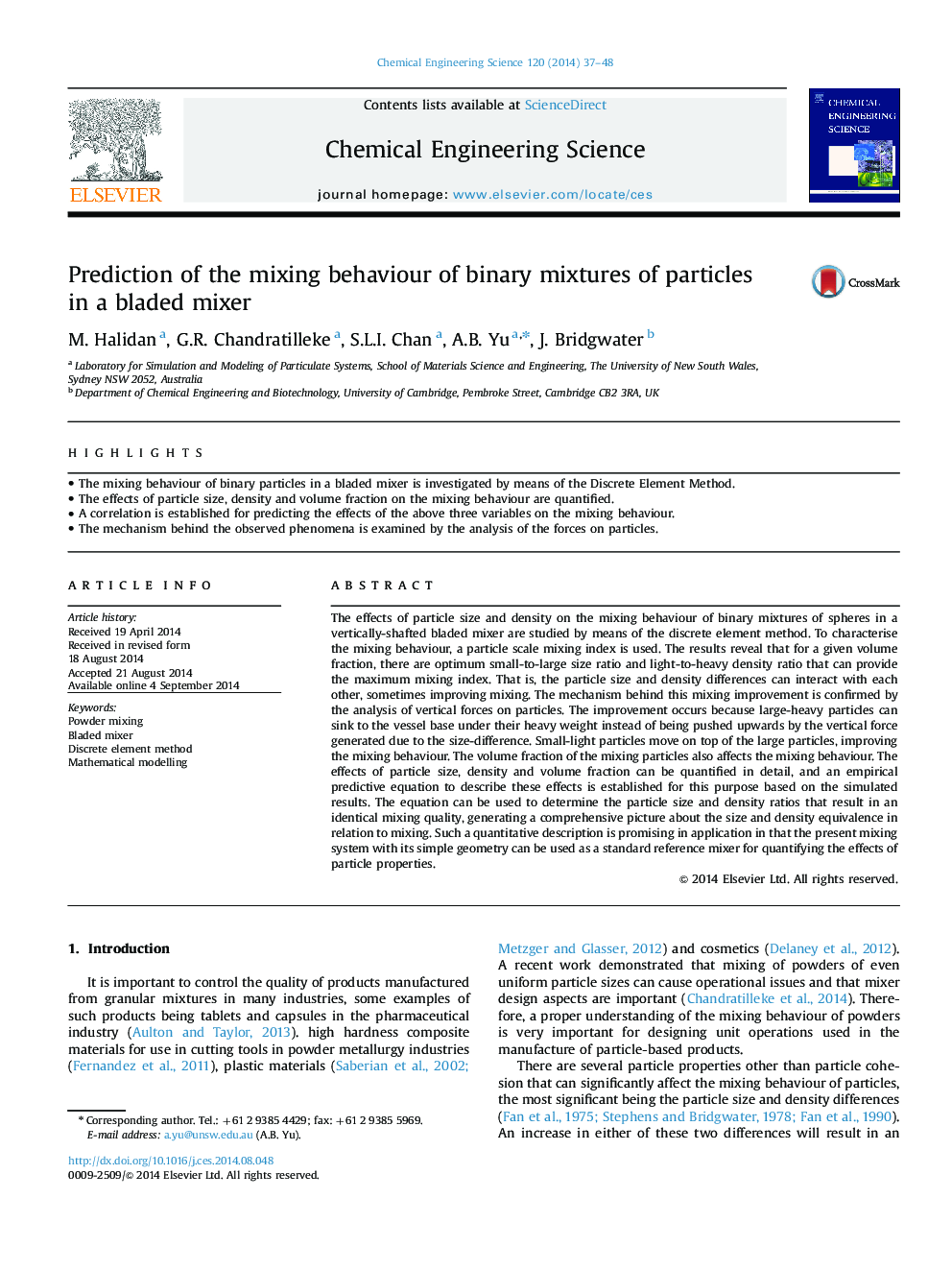| کد مقاله | کد نشریه | سال انتشار | مقاله انگلیسی | نسخه تمام متن |
|---|---|---|---|---|
| 6590938 | 456862 | 2014 | 12 صفحه PDF | دانلود رایگان |
عنوان انگلیسی مقاله ISI
Prediction of the mixing behaviour of binary mixtures of particles in a bladed mixer
ترجمه فارسی عنوان
پیش بینی رفتار مخلوط کردن مخلوط دوتایی ذرات در یک میکسر رولر
دانلود مقاله + سفارش ترجمه
دانلود مقاله ISI انگلیسی
رایگان برای ایرانیان
کلمات کلیدی
مخلوط کردن پودر، میکسر مخلوط، روش عنصر گسسته، مدل سازی ریاضی،
ترجمه چکیده
اثرات اندازه و تراکم ذرات بر رفتار مخلوط کردن مخلوط دوتایی از کره ها در یک مخلوط کننده لایه ای عمودی با استفاده از روش عنصر گسسته مورد بررسی قرار می گیرد. برای مشخص کردن رفتار مخلوط کردن، یک شاخص مخلوط کردن مقیاس ذرات استفاده می شود. نتایج نشان می دهد که برای یک کسر حجم داده شده، نسبت اندازه کوچک به اندازه بزرگ و نسبت تراکم سبک / سنگ به شدت افزایش می یابد که می تواند حداکثر شاخص مخلوط را فراهم کند. به عبارت دیگر، اندازه ذرات و تفاوت تراکم می توانند با یکدیگر همکاری کنند، گاهی اوقات باعث بهبود ترکیب می شوند. مکانیسم پشت این بهبود مخلوط توسط تجزیه و تحلیل نیروهای عمودی بر روی ذرات تایید شده است. بهبودی به این دلیل رخ می دهد که ذرات بزرگ سنگین می توانند به پایه کشتی تحت وزن سنگین خود غرق شوند، به جای اینکه با نیروی عمودی تولید شده به دلیل تفاوت اندازه بزرگ به سمت بالا حرکت کنند. ذرات کوچک نور در بالای ذرات بزرگ حرکت می کنند، رفتار رفتار مخلوط را بهبود می بخشد. مقدار حجم ذرات مخلوط نیز بر رفتار مخلوط تاثیر می گذارد. اثرات اندازه ذرات، تراکم و کسر حجمی را می توان با کمی اندازه گیری کرد و معادله پیش بینی تجربی برای توصیف این اثرات برای این منظور براساس نتایج شبیه سازی شده ایجاد شده است. معادله را می توان برای تعیین اندازه ذرات و نسبت تراکم که منجر به یک کیفیت مخلوط یکسان است، تولید یک تصویر جامع در مورد اندازه و هم پوشانی چگالی در رابطه با مخلوط کردن. چنین توصیفی کمی در کاربرد کاربرد دارد، زیرا در حال حاضر سیستم مخلوط با یک هندسه ساده می تواند به عنوان یک میکسر مرجع استاندارد برای اندازه گیری خواص خواص ذرات استفاده شود.
موضوعات مرتبط
مهندسی و علوم پایه
مهندسی شیمی
مهندسی شیمی (عمومی)
چکیده انگلیسی
The effects of particle size and density on the mixing behaviour of binary mixtures of spheres in a vertically-shafted bladed mixer are studied by means of the discrete element method. To characterise the mixing behaviour, a particle scale mixing index is used. The results reveal that for a given volume fraction, there are optimum small-to-large size ratio and light-to-heavy density ratio that can provide the maximum mixing index. That is, the particle size and density differences can interact with each other, sometimes improving mixing. The mechanism behind this mixing improvement is confirmed by the analysis of vertical forces on particles. The improvement occurs because large-heavy particles can sink to the vessel base under their heavy weight instead of being pushed upwards by the vertical force generated due to the size-difference. Small-light particles move on top of the large particles, improving the mixing behaviour. The volume fraction of the mixing particles also affects the mixing behaviour. The effects of particle size, density and volume fraction can be quantified in detail, and an empirical predictive equation to describe these effects is established for this purpose based on the simulated results. The equation can be used to determine the particle size and density ratios that result in an identical mixing quality, generating a comprehensive picture about the size and density equivalence in relation to mixing. Such a quantitative description is promising in application in that the present mixing system with its simple geometry can be used as a standard reference mixer for quantifying the effects of particle properties.
ناشر
Database: Elsevier - ScienceDirect (ساینس دایرکت)
Journal: Chemical Engineering Science - Volume 120, 16 December 2014, Pages 37-48
Journal: Chemical Engineering Science - Volume 120, 16 December 2014, Pages 37-48
نویسندگان
M. Halidan, G.R. Chandratilleke, S.L.I. Chan, A.B. Yu, J. Bridgwater,
